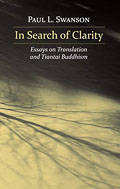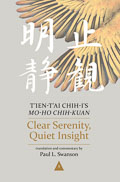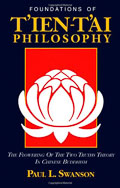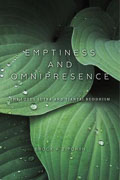start > Klassieke teksten > Personen/auteurs > auteur
Zhiyi 智顗 [Chih-i]
Zhiyi 智顗 [Chih-i] (538-579)
Zhiyi is one of the most influential monks in Chinese Buddhist history and de facto founder of the Tiantai Zong. A native of Jingzhou (in present-day Hunan province), Zhiyi was ordained at the age of eighteen after his parents died during the wartime turmoil that preceded the Sui dynasty’s unification of China. He studied VINAYA and various MAHĀYĀNA scriptures, including the SADDHARMAPUN ̇ D ̇ ARĪKASŪTRA (“Lotus Sūtra”) and related scriptures. In 560, Zhiyi met NANYUE HUISI (515–577), who is later listed as the second patriarch of the Tiantai lineage, on Mt. Dasu in Guangzhou and studied Huisi’s teachings on the suiziyi sanmei (cultivating SAMĀDHI wherever mind is directed, or the samādhi of freely flowing thoughts), the “four practices of ease and bliss” (si anle xing), a practice based on the Saddharmapundarīkasūtra, and the lotus repentance ritual. Zhiyi left Huisi at his teacher’s command and headed for the southern capital of Jinling (present-day Jiangsu province) at the age of thirty (567) to teach the Saddharmapundarīkasūtra and the DAZHIDU LUN for eight years at the monastery of Waguansi.
The Shi chanboluomi cidi famen [alt. Cidi chanmen] are his lecture notes from this period of meditation and teaching. In 575, he retired to Mt. Tiantai (present-day Zhejiang province), where he built a monastery (later named Xiuchansi by the emperor) and devoted himself to meditative practice for eleven years. During this time he compiled the Fajie cidi chumen and the Tiantai xiao zhiguan.
After persistent invitations from the king of Chen, Zhiyi returned to Jinling in 585 and two years later wrote the FAHUA WENJU, an authoritative commentary on the Saddharmapu ̇n ̇darīkasūtra. Subsequently in Yangzhou, Zhiyi conferred the bodhisattva precepts on the crown prince, who later became Emperor Yang (r. 604–617) of the Sui dynasty. Zhiyi was then given the title Great Master Zhizhe (Wise One). Zhiyi also established another monastery on Mt. Dangyang in Yuquan (present-day Hunan province), which Emperor Wen (r. 581–604) later named Yuquansi.
Zhiyi then began lecturing on what became his masterpieces, the FAHUA XUANYI (593) and the MOHE ZHIGUAN (594). At the request of the king of Jin, in 595 Zhiyi returned to Yangzhou, where he composed his famous commentaries on the VIMALAKĪRTINIRDEŚA, i.e., the Weimojing xuanshou and the Weimojing wenshou, before dying in 597. Among the thirty or so works attributed to Zhiyi, the Fahua xuanyi, Fahuawenju, and Mohe zhiguan are most renowned and are together known as the Tiantai san dabu (three great Tiantai commentaries). (Bushwell 2014 The Princeton Dictionary of Buddhism p 911-912)
Brook Ziporyn geeft de voldende typering van Zhiyi:
Zhiyi (Tiantai Zhizhe dashi) (538–597) was the nominal third patriarch of the Chinese TIANTAI SCHOOL, but he was, in fact, its eponymous founder. Zhiyi was born in Jingzhou (present-day Hubei), and became a monk at the age of eighteen, taking the full precepts two years later. At the age of twenty-three, he went to study with Nanyue Huisi (d. 577), under whom he practiced the Lotus Samadhi, during which he had a breakthrough experience. At thirty, he went to Jinling, capital of the Chen kingdom, and began to lecture extensively.
Zhiyi taught for the rest of his life, his lectures transcribed by his disciples, most notably Guanding (561–632), who recorded the “three great works of Tiantai”: Fahua wenju (Commentary on the Lotus Sutra), Fahua xuanyi (Profound Meaning of the Lotus Sutra), and More Zhiguan (Great Calming and Contemplation), the first based on lectures given in 587 and the latter two based on lectures given in 593 and 594. Zhiyi also composed several works by his own hand, most notably a commentary on the Vimalaklirtinirdesa, written at the request of the Jin ruling house.
Zhiyi’s teaching stresses the simultaneous and equal development of both doctrinal understanding and meditative practice. He devised an elaborate system of classification of Buddhist teachings, making a coherent whole of the mass of Buddhist scriptures translated into Chinese, in accordance with his development of the true meaning of UPAYA (skillful means) as expounded in the LOTUS SUTRA and NIRVANA SUTRA. His teaching combined the Lotus notion of upaya and mutual entailment with Madhyamaka notions of SUNYATA (EMPTINESS) and conventional truth and the buddha-nature concept from the Nirvana Sutra, by which Zhiyi devised the doctrine of the three truths —emptiness, provisional positing, and the mean— as a comprehensive template for understanding Buddhist teachings and practices. This doctrine holds that every element of experience is necessarily and simultaneously (1) determinate, (2) ambiguous, and (3) absolute, and that these three predicates are ultimately synonymous. This led to a distinctive understanding of the interpervasion of all dharmas as suggested in the HUAYAN JING, which in Zhiyi’s understanding led to the doctrine of “the three thousand quiddities inherently entailed as each moment of experience,” as well as the further doctrines of “the evil inherent in the Buddha-nature,” the non-obstruction of enlightenment between delusion, and the equal ultimacy of all possible doctrinal positions, as mediated by the Lotus doctrine of upaya. Zhiyi also rewrote the Indian mind-only doctrine so that it could be equally restated as a claim that all reality is matter-only, or alternately scent-only, taste-only, touch-only, and so on. His ideas were influential in every aspect of later East Asian Buddhism; they were commented on and reinterpreted in every generation within the Tiantai school, and recast and responded to by the HUAYAN SCHOOL, which amended his classification scheme and reinterpreted the interpervasion of all dharmas in a new way. Zhiyi’s hermeneutical technique, in particular his metaphorical “mind-contemplation gloss” for reading the scriptures, was instrumental in the early develop- ment of the CHAN SCHOOL. (Ziporyn in Buswell 2004 p 927-28)
Het classificatieschema van Zhiyi wordt door Yu Chun-Fang uitgelegd:
Zhiyi divided the Buddha’s teaching career into five periods and assigned representative sutras to each period, beginning after the Buddha’s enlightenment.
- The first period lasted only three weeks. The sutra taught was the Huayan or Flower Garland Sutra. But because it was too profound, no one understood it.
- The second period lasted twelve years, during which the Buddha taught the Hinayana Āgama scriptures of the Four Noble Truths, the Noble Eightfold Path, and the Law of Dependent Origination. These are teachings suitable for people of lesser ability.
- The third period lasted eight years, during which the Buddha taught elementary Mahayana sutras called Vāipulya (fangdeng, “broad and equal”). These scriptures exalt the superiority of Mahayana over Hinayana and the bodhisattva ideal over that of arhat.
- The fourth period lasted twenty-two years, during which the Buddha taught the Perfection of Wisdom scriptures, which represent the mature Mahayana teaching of śunyatā.
- The fifth period covers the last eight years of the Buddha’s life. He taught the Lotus Sutra and the Nirvana Sutra, which proclaim buddhahood for all. They represent the Buddha’s final and most profound teaching.1
In deze classificatie is de eerst periode de minst en de laatste periode de meest relevante periode.: "The Tiantai doctrinal classification, like that of the Huayan school, was an attempt to include all Buddhist scriptures within the teaching career of the Buddha in an ascending order. While this did not accord with historical reality, it demonstrated a spirit of inclusiveness and comprehensiveness."
For Zhiyi, the Lotus Sutra was the pinnacle of the Buddha’s teaching. His lectures on the Lotus Sutra were recorded by his disciple Guanding (561–632) and have remained the classics of the Tiantai school.
Both the doctrine of three truths and that of nature inclusion are unique to Tiantai. The three truths are the truth of emptiness, the truth of temporariness, and the truth of the mean. While they are based on the two truths Nāgārjuna taught in his “Verses of the Middle Way,” they represent a creative synthesis. The two truths refer to the ultimate truth and the con- ventional truth. Because all things are dependent on causes and have no independent nature, they are said to be empty. This is the ultimate truth. Although they are empty, things are not nonexistent because they do exist contingently. This is the conventional truth. The third truth of the mean or the middle way is the insight that all things are empty and temporary at the same time in reality. The three truths should not be viewed as separate or sequential, but as three integrated and simultaneous ways of understanding the ultimate reality. This threefold vision infuses the world right here and now with ultimate meaning. There is no reality outside and beyond the phenomenal world. If we see everything around us this way, then nirvana is not separate from samsara. This philosophical doctrine affirms this world of ours. It is no wonder that Tiantai became a leading Chinese Buddhist school. It accords with the traditional Chinese worldview, which does not segregate the sacred from the secular.
(Yu Chun-Fang 2020 Chinese Buddhism: a thematic History p 156-57)
Klassieke teksten
- schrijver van de Fahua Wenzhu ()- schrijver van de Fahua Xuanyi (Profound Meaning of the Lotus Sutra)
- schrijver van de Mohe zhiguan (Great Calming and Contemplation / Clear Serenity, Quiet Insight)
Noten
Deze classificatie systemen worden panjiao 判教 genoemd
Jonathan Silk:
The first to have presented such a system may have been the monk Daosheng (道生; 317–420), a disciple of the famous Kumārajīva (Hu, 2014, 70), but a number of systems competed over time; as the author of the most influential system, the Tiantai (天台) founder Zhiyi (智顗; 538–597), noted, there were three such systems in southern Chinese Buddhism, based on the chronological order of Buddha’s preaching (the Three Periods [三時], Four Periods [四時], and Five Periods [五時]), while in the north there were seven systems (Hu, 2014, 71). The chronology of the Buddha’s preaching is considered here to be of utmost significance, with priority placed on his last and final teaching. This contrasts with at least some Indian interpretations of the stock phrase introducing sūtras, “at one time the Blessed One . . .”: some commentaries suggest that no specific indication of time is given because the exact time is not of importance, but clearly Chinese exegetes disagreed.
Zhiyi himself in his Fahua xuanyi (法華玄義; T. 1716) arranges the Buddha’s teaching into five phases:
1. Buddha’s first preaching, the Buddhāvataṃsaka- sūtra for all disciples (3 weeks);
2. the Āgama for Hīnayāna generally (12 years);
3. the Vaipulya (Fangdeng jing [方等經]) for Mahāyāna common teaching (8 years);
4. the Prajñāpāramitāsūtra for Mahāyāna special teaching (22 years);
5. the Lotus and Nirvāṇa Sūtras, for the perfect teaching of Mahāyāna (8 years; Hu, 2014, 82).
Different panjiao systems advocate different final and ultimate teachings, even while acknowledging the validity of all the Buddha’s teachings. For Jizang (吉藏; 549–623), all Mahāyāna sūtras display the path without ever the slightest difference (Fahua xuan lun [法華玄論]; T. 1720 [XXXIV] 378c14–15; and Fahua yishu [法華義疏]; T. 1721 [XXXIV] 518c16; Hu, 2014, 89). In contrast to this perspective, however, many believed that the scriptures could be arranged into hierarchies of importance. (Jonathan Silk 2015 Canonicity p20-21
Buswell 2014 In Chinese, “tenet classifications,” “doctrinal taxonomies.” See JIAOXIANG PANSHI.
jiaoxiang panshi. (教相判釋). In Chinese, lit., “classification and interpretation of the characteristics of the doctrine”; also known as jiaopan or panjiao. (判教) (tenet classification, doctrinal taxonomies).
Tenet classification was a fundamental exegetical practice in East Asian Buddhism, in which scriptures or Buddhist teachings were ranked in order of their supposed relative profundity. The practice flourished in East Asia, especially during the fifth, sixth, and seventh centu ries. As more translations of Buddhist texts became available in East Asia, indigenous exegetes struggled with the question of why this plethora of scriptural material, all of which pur- ported to have been spoken by the Buddha himself, offered such differing presentations of Buddhist thought and practice. Drawing on the notion of UPĀYA, or skill in means, exegetes began to reflect on the context and intent of the different Buddhist scriptures that were now available to them. The origin of scriptures and their teachings were analyzed and eval- uated comparatively; after which the texts were organized in a hierarchical or, in some cases, chronological, order. Different exegetical traditions adopted different classification criteria.
Buswell 2014 The Princeton Dictionary of Buddhism p385
Literatuur
Boeken 1 tot 5 van de 5

Stevenson, Dan (1993). The Great Calming and Contemplation: A Study and Annotated Translation of the First Chapter of Chih-i's 'Mo-ho Chih-kuan' . University of Hawaii Press.
ISBN13: 978-0824815141
Meer informatie...
Swanson, Paul L. (2018). In Search of Clarity: Essays on Translation and Tiantai Buddhism. Chisokudo Publications. *
--- (2017). Clear Serenity, Quiet Insight. University of Hawaii Press.2280 pages, vertaling en annotatie van de Mohe zhiguan
ISBN13: 978-0824873776
Meer informatie...
--- (1989). Foundations of T'ien-T'ai Philosophy: The Flowering of the Two Truths Theory in Chinese Buddhism. *ISBN10: 089561918X
Ziporyn, Brook (2016). Emptiness and Omnipresence - The Lotus Sutra and Tiantai Buddhism: An essential introduction to Tiantai Buddhism. Indiana University Press. *
ISBN13: 978-0253021120
Boeken 1 tot 5 van de 5




